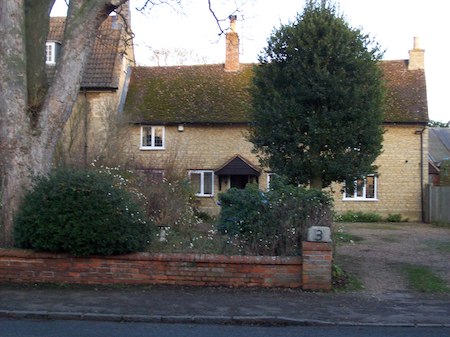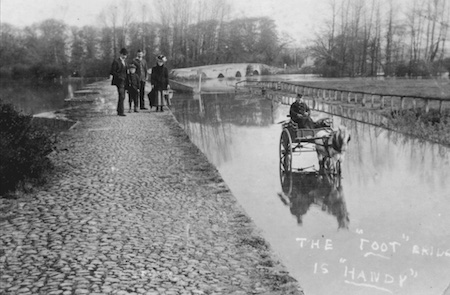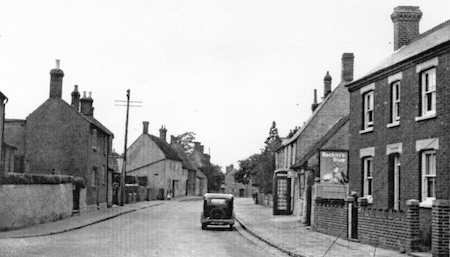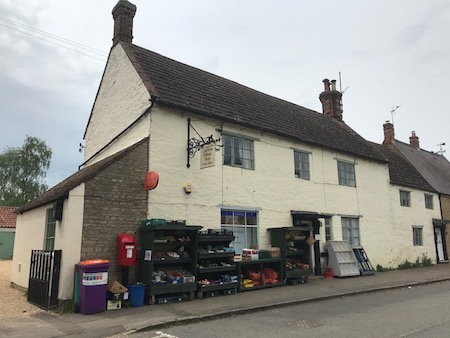Carlton & Chellington Post Office
This page was contributed by Pamela Hider
Carlton & Chellington didn't receive an official postal service until 1847. Letters came through Harrold and the Receiver in Carlton was John Whitworth, a farmer of Chellington.
In 1859 a sub post office was authorised at Carlton and the first sub postmaster was James Keech, appointed 1860, a baker of Carlton, who combined the sub post office with a bakery at Bridgend. James was removed from service in 1872 when he lost his sight.
In 1872, Samuel Fairey, a farmer of Bridgend,was appointed.We know the Faireys lived at Chellington House in Bridgend and that they also owned the Den adjoining, no.3 Bridgend. Ordnance Survey maps show us the Post Office was at the Den, so this is the first time we know the Post Office's location. Samuel combined the sub post office with being a butcher.

The Den, 3 Bridgend, Chellington
Letters were via Bedford and from 1871, there are records of Rural Messengers who rode to Carlton in pony and trap to deliver the mail. From 1888, letters went via Sharnbrook.

Rural Postman Joseph Clayton Bayes is bringing the mail from Sharnbrook to Carlton through the floods c.1902. Courtesy of Carlton and Chellington Historical Society
Samuel had resigned in December 1875 and Joseph James, a shepherd from Melchbourne, was appointed in September 1876, although in the censuses of 1881 & 1891, his wife, Annie is described as Postmistress (and Joseph as a shepherd). Joseph died in December 1894 and in January 1895, Annie was officially appointed as Postmistress . She had no Assistant and worked 12 hour days. In practice, she held the post for 35 years, until at least 1911 when she was 69 years old (censuses 1901 & 1911).
Annie James
Annie was indeed a singular woman, who was a pioneer of her time in the Victorian age. She was born Ann Pitts in the last quarter of 1841 at Oundle, Northamptonshire, and had married Joseph in 1859. During the next 8 years she produced five children. By 1876 she and her family were in Bedfordshire, when her husband Joseph was appointed. In that same year, the Post Office introduced a “marriage bar” which required most female employees to resign upon marriage and forbade the employment of married women in the majority of positions. This did not prevent Joseph from continuing his work as a shepherd, whilst Annie became the de facto Postmistress of Carlton & Chellington. Although the "marriage bar" was relaxed during WW1 and not abolished until 1946, this meant that Annie was well ahead of her time in setting a precedent. And so was Bedfordshire in appointing her.
However, there may have been some trepidation, as in the Post Office Misconduct Book, kept by the Head Postmaster at Bedford, several complaints against her are recorded during the years 1907-10. In 1909, it was written that 'The Postmaster considered whether she should be allowed to remain in post given her age (67). He reported that "She cannot be described as thoroughly efficient, but as she is wholly dependent on the PO work as her means of livelihood and has held office for nearly 15 years....[actually 33 years], I am satisfied that she performs her duties to the best of her abilities" '.
Electoral Registers show Annie to be living in Chellington until at least 1914. No such records were kept during the war years, but from 1918-22 she was shown to be living at The Green, Harrold. From 1923-30 she was shown to be living once again in Chellington. She died in June 1931 aged 89 years, and was buried in the graveyard of St. Nicholas, Chellington.
1914
The new sub postmaster was now Christopher Crouch, a "jobbing gardener", and he ran the Post Office from a new location at No.10 Bridgend. His last appearance with the Post Office in the Electoral Rolls was in 1938. He died in 1942.
Records show that Priscilla & Harry Weekley had run The Stores at No.31 Bridgend (known as Crossways) in 1938 -39 and presumably throughout the war years. Tradition has it that The Stores also acted as The Post Office and a photo exists of a telephone box 'outside the post office'. This same telephone box was later moved further along the road to stand outside The Royal Oak when Crossways ceased to be the Post office.

Telephone box outside post office at 31, Bridgend c.1938-1945. Courtesy of Carlton and Chellington Historical Society.
No records were kept during the war years, but from 1945 - 52, The Weekleys are registered as still running the Post Office.
Bertram Wooding, who lived at no.12 Bridgend and ran The Bakery there, bought no.31, transferred the rights to The Bakery then sold no.31 as a private dwelling. The Royal Oak is opposite no.12 and would’ve been nearer to the ‘new’ post office as well as affording space for the phone box.
No.12 is described by HER as "Two houses now amalgamated into a single unit as house and shop. N. house has datestone 1624 and was altered C18". It was described as 'Village Stores' in the Electoral Registers from 1954 and as 'Post Office Stores' from 1964 - 69. It has remained Carlton Village Shop and Post Office ever since.

Carlton Shop & Stores 2021
Further References:
Post Office Directories
Post Office Archives
Trade Directories
Post Office Establishment Books for Head Post Offices at Bedford, starting series X378/4
Articles for Bedford Architectural Archaeological & Local History Society by Bob Ricketts
Carlton & Chellington Historical Society
Historic Environment Record